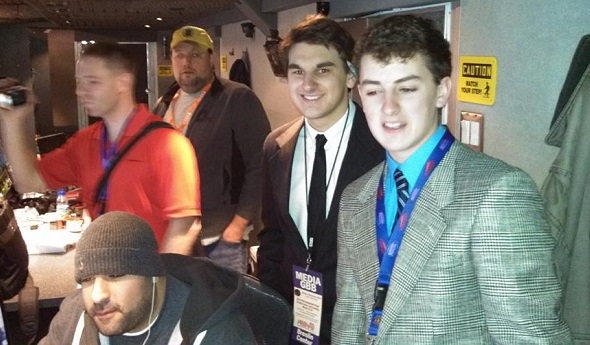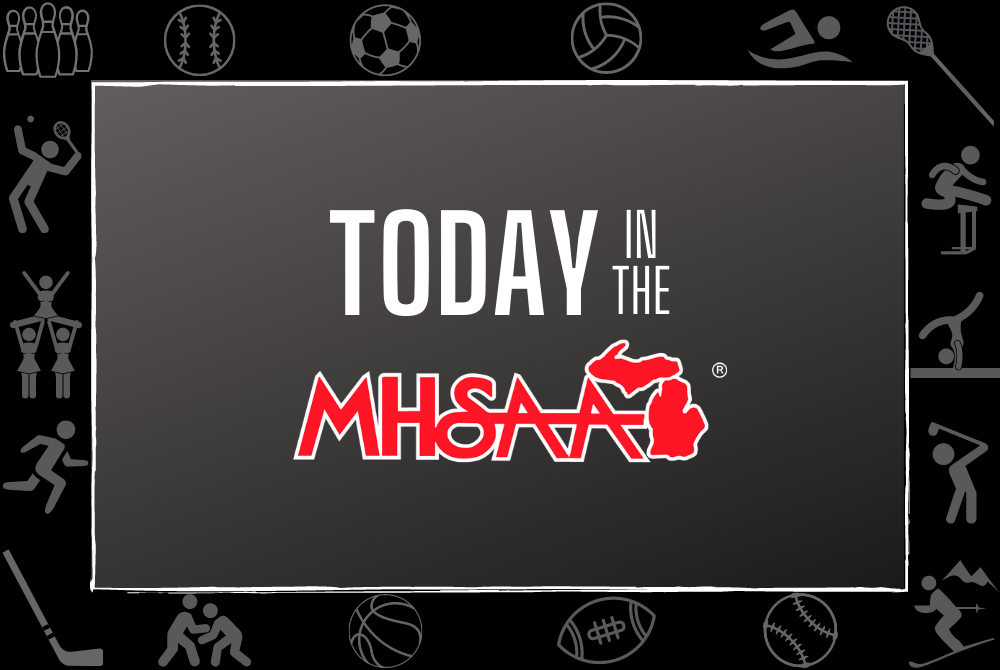
SBP Brings Our Schools to You
August 25, 2014
By John Johnson
MHSAA communications director
Coaches used to come and go each weekend during the football season. Late at night they would drop their game films off at a local 24-hour gas station or diner; and a couple of nights later, they’d return to pick up the processed film to use in preparation for the next game.
That was life in the 1950s, 60s and 70s. It was difficult for students to get into a visual medium like film in general, and certainly in sports. The equipment was bulky and hard to operate, and the film went to some central location for processing which took at least a couple of days. Editing the stuff when it came back took a splicing machine, tape and glue to make even the simplest edit – and that’s assuming your school was lucky enough to have that gear.
Say the word “film” to a young person now, and they may recall seeing it in a history book or finding a box of old negatives or home movie reels in their grandparents’ attic.
Today’s high school students have endless possibilities because with a little creativity and vision, they can be hands on producing their schools’ athletic and non-athletic events and reach out to members of their schools’ global community to show them the homecoming parade, game, musical or graduation. Aunt Millie in Montana doesn’t have to wait for that phone call later that weekend to find out that Johnny scored three touchdowns. She watched all of them live, and texted him on the bus on the way home to congratulate him as he watched the game on demand on his handheld device.
More and more schools are keeping their communities connected by broadcasting their games over the Internet, and there are more schools in Michigan and nationwide providing that opportunity under the banner of the School Broadcast Program.
Powered by PlayOn! Sports and the NFHS Network, there are 860 schools in 38 states regularly producing events and giving the students producing those games some real-life hands-on broadcasting experience in the process.
“The PlayOn! Sports platform gives schools the opportunity to be successful at creating video broadcasts of their events regardless of their enrollment and resources,” said Mark Rothberg, Vice President of PlayOn! Sports, who handles the day-to-day administration of the School Broadcast Program. “You can produce a great-looking event with a simple crew of three kids handling the announcing, the camera and generating graphics on the computer; and if you’re fortunate to have the resources to create productions using multiple cameras and replays, you’ll look even better.
“Our partnership with the NFHS Network and most state associations creates a single portal, unlike anything a school can do on its own or by utilizing other streaming services, where fans of high school sports can keep up with the team in their backyard or other schools around the country where they have family or friends participating. It’s truly the destination for high school sports.”
More than half of Michigan schools participating in the NFHS Network School Broadcast Program have signed up through the Michigan Interscholastic Connection, and those schools have produced the majority of the SBP content on MHSAA.tv the past two years.
“What we try to do with our schools first is see if video production can be integrated into the curriculum, so that even though athletics is the driving force behind the School Broadcast Program, the athletic department doesn’t have to worry about adding this to an already long to-do list,” said Sparky Nitchman of the Michigan Interscholastic Connection. “Every school is unique, so our process is very individualized, aiming at providing the resources that each school needs in order to provide the best environment possible for a flourishing, long-term broadcasting class.
“We try to be very hands-on with our schools in giving them guidance in the classroom and at events, and with the marketing side of the program.”
Membership in the School Broadcast Program is free. PlayOn! Sports makes sure schools secure the proper equipment to run the software and has a dedicated support team to provide telephone and e-mail assistance should something occur during a production. Schools can live stream as many athletic events annually as they can on a customized school branded portal under the MHSAA.tv and NFHSNetwork.com websites. Live internet video broadcasts are permissible by MHSAA Handbook rules when they are produced by member schools and are available on a subscription or password-protected basis.
The subscription model provided by PlayOn! Sports provides a tool for schools to generate new revenue. Beginning this fall, schools can sell their fans annual subscription passes at a deeply discounted rate and receive a significant revenue share on each pass sold. Schools will continue to have the opportunity to sell advertising within their broadcasts in a way that they typically cannot if an event is being streamed on the school district’s website.
“We’ve already had schools on the subscription program happily surprised when, at the end of a season, we mailed them a four-figure check from subscription revenue,” Rothberg said. “The opportunity for financial success as a School Broadcast Program member is very real if a school works hard at marketing and then does a solid job of producing events.”
In addition to the educational experience students receive producing events, a number of students at SBP schools who graduated this spring chose to attend colleges with strong broadcasting curriculums or athletic broadcast departments, or trade schools like Specs-Howard. These kids have found an exciting activity to participate in and are getting real experience in the production field.
“Kids who may have felt they were on the outside edge of things at school have found something in the School Broadcast Program that does the same thing for them that athletics do for so many other kids,” said John Johnson, communications director for the MHSAA, who helps manage the day-to-day operation of the SBP with member schools. “It gives them a reason to get up in the morning to go to school, do well in school, and interact with kids they may never have dreamed that they’d be rubbing elbows with. All through the power of sports, and a medium that so many of them are naturally attracted to anyway in this digital age.”
The MHSAA always has had strong ties to the broadcasting community. While the days are gone of 40 to 50 local radio stations originating all four games of the Boys Basketball Finals – even if their community representative had been already knocked out of the tournament – those same stations now pick up an MHSAA Network originated feed of the Boys and Girls Basketball Finals.
For nearly a decade, the MHSAA has partnered with the Michigan Association of Broadcasters Foundation to support the latter’s Student Broadcasting Awards, with some of the Public Service Announcements created in those contests being broadcast statewide. Students winning the Sports Play-By-Play category even get an opportunity to sit courtside during a Finals event and call the action on the MHSAA Network website.
Also, a new alliance has been formed with the Student Broadcast Foundation to create field trip days to selected MHSAA tournament events, where students can meet with broadcasting industry professionals, watch the productions behind the scenes and even call or produce a mock audio broadcast of a game.
PHOTO: Davison students tour the Fox Sports Detroit broadcast truck during the 2013-14 school year.

Today in the MHSAA: 10/24/24
By
Geoff Kimmerly
MHSAA.com senior editor
October 24, 2024
1. BOYS SOCCER No. 2 Flint Powers Catholic edged No. 3 Imlay City in a Division 3 Regional Semifinal – Port Huron Times Herald
2. BOYS SOCCER No. 5 Mason advanced in its Division 2 Regional with a shootout win over Bloomfield Hills Cranbrook Kingswood – Oakland Press
3. BOYS SOCCER Top-ranked Pontiac Notre Dame Prep downed Frankenmuth 4-1 in Division 3 – WJRT
4. BOYS SOCCER No. 4 Allendale downed Coldwater 3-0 in a Division 2 Regional Semifinal – WTVB
5. VOLLEYBALL Division 1 honorable mention Traverse City Central finished a season sweep of rival West – Traverse City Record-Eagle
6. VOLLEYBALL Alpena came back from losing the first set to defeat Gaylord in four on Senior Night – Alpena News
7. VOLLEYBALL Hancock earned a road sweep at Lake Linden-Hubbell – Houghton Daily Mining Gazette
8. VOLLEYBALL Midland Bullock Creek and Beaverton earned Jack Pine Conference sweeps – Midland Daily News

